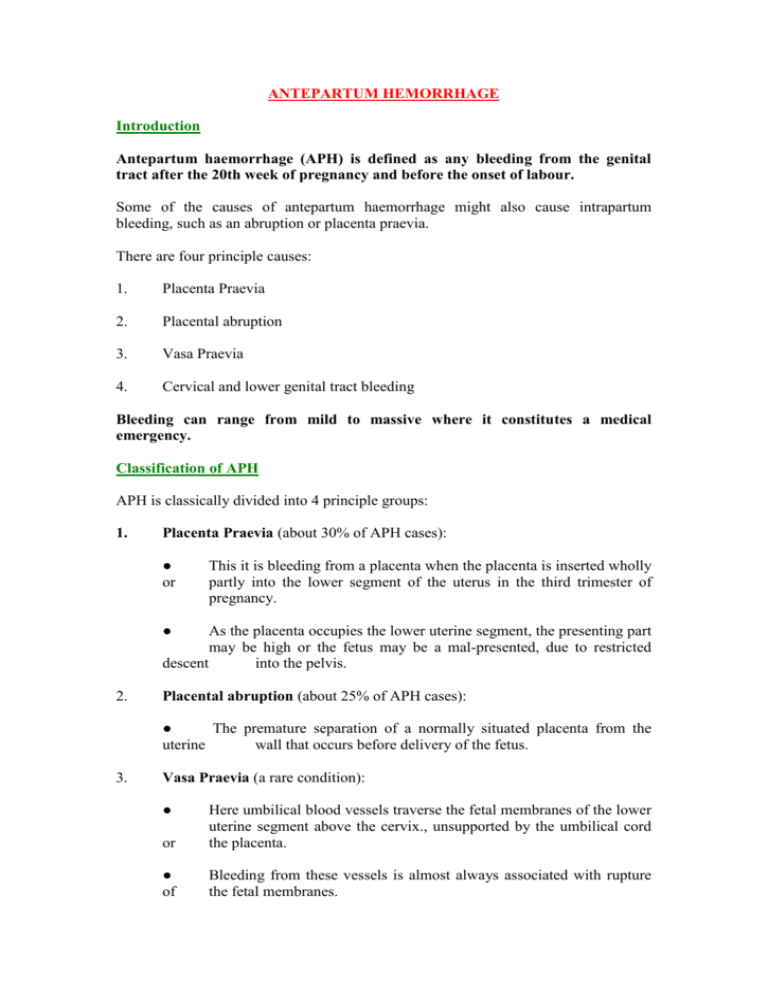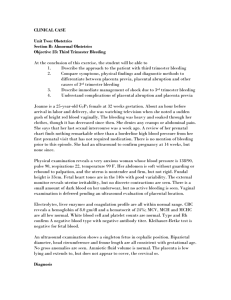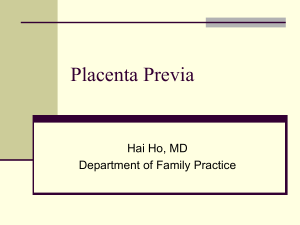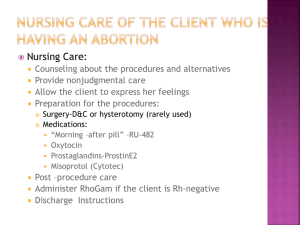ANTEPARTUM HEMORRHAGE
advertisement

ANTEPARTUM HEMORRHAGE Introduction Antepartum haemorrhage (APH) is defined as any bleeding from the genital tract after the 20th week of pregnancy and before the onset of labour. Some of the causes of antepartum haemorrhage might also cause intrapartum bleeding, such as an abruption or placenta praevia. There are four principle causes: 1. Placenta Praevia 2. Placental abruption 3. Vasa Praevia 4. Cervical and lower genital tract bleeding Bleeding can range from mild to massive where it constitutes a medical emergency. Classification of APH APH is classically divided into 4 principle groups: 1. Placenta Praevia (about 30% of APH cases): ● or This it is bleeding from a placenta when the placenta is inserted wholly partly into the lower segment of the uterus in the third trimester of pregnancy. ● As the placenta occupies the lower uterine segment, the presenting part may be high or the fetus may be a mal-presented, due to restricted descent into the pelvis. 2. Placental abruption (about 25% of APH cases): ● The premature separation of a normally situated placenta from the uterine wall that occurs before delivery of the fetus. 3. Vasa Praevia (a rare condition): ● or Here umbilical blood vessels traverse the fetal membranes of the lower uterine segment above the cervix., unsupported by the umbilical cord the placenta. ● of Bleeding from these vessels is almost always associated with rupture the fetal membranes. 4. Cervical and lower genital tract bleeding (about 45% of APH cases): ● This includes bleeding from the cervix or vagina. Pathophysiology Placenta Praevia This is bleeding from separation of an abnormally placed placenta Placenta previa generally is defined as the implantation of the placenta over or near the internal os of the cervix. From the second trimester, a placenta praevia may be also associated with vasa praevia (see below). Classification: Traditionally placenta praevia was classified into 4 types: Type 1: The placenta is in the lower segment but does not reach the internal os. Type 2: The placenta reaches the margin of the internal os. Type 3: The placenta partially covers the internal os. Type 4: The placenta completely covers the internal os Placenta praevia is now more commonly classified as simply major or minor: ● Minor placenta praevia (Type I &II): ♥ ● Placenta not lying over the cervical os but encroaching on the lower uterine segment. Major placenta praevia (Type III &IV): ♥ Placenta lying over the cervical os. Additionally placenta praevia can be classified according to the degree of placental adherence to the uterus: ● Placenta accreta (superficial) ● Placenta increta (into muscle) ● Placenta perceta (through muscle). Risk factors: 1. but A low lying placenta occurs in 5% of pregnancies at 16 - 18 weeks gestation are evident in only 0.5% pregnancies at term. The change of placental position results from the formation of the lower uterine segment and which moves the placenta upwards with the expanding uterus. 2. The incidence of placenta praevia is higher in women with a previous caesarean section and increases in prevalence with each caesarean section. Complications: 1. Hemorrhaging 2. Fetal effects: The fetal effects of placenta praevia, that are seen in the longer term, may include: ● be ● Intrauterine growth restriction (IUGR), due to abnormal placental implantation and vascularisation in the area of the uterus destined to the lower segment A higher incidence of premature pre-labour rupture of the membranes (PPROM), which is thought to be as a result of the blood affecting the integrity of the membranes. Placental abruption Abruption is an antepartum haemorrhage due to the premature separation of a normally situated placenta from the myometrial wall that occurs before delivery of the fetus. The exact aetiology is unknown, but the final pathophysiology is likely rupture of a spiral artery with haemorrhage into the decidua basalis leading to separation of the placenta. The small vessel disease seen in abruptio placentae may also result in placental infarction. Placental abruption is associated with a high maternal and neonatal morbidity and mortality. Classification: Placental abruption can be classified in a number of ways: Revealed verses concealed: The bleeding may be may be: 1. Revealed: ● 2. When blood escapes through the vagina, Concealed: ● When the bleeding occurs behind the placenta, with no evidence of bleeding from the vagina. Note that when there is revealed bleeding it is also likely that there is a significant concealed proportion of bleeding as well. Degree of separation: Abruption may also be classified according the degree of separation that occurs, usually as class I, II, III, or IV. The increasing degree of abruption will correlate with increasing signs of maternal and fetal compromise and biochemical abnormalities. Position of the abruption: According to the position of the abruption within the placenta it can be classified as: ● Marginal placental abruption: most common by far ● Retro-placental abruption ● Pre-placental abruption Risk factors: Risk factors for placental abruption include: 1. Trauma e.g. motor vehicle accident: ● This is a major risk factor ● for A woman involved in trauma, such as an MVA, should be evaluated abruption. An abruption may occur in the absence of direct abdominal trauma or, an abruption may become apparent several hours or days after the trauma. 2. Chronic hypertension 3. Preeclampsia 4. Thromobphilia 5. Previous placental abruption 6. Smoking 7. Drug abuse: in particular cocaine abuse. 8. Chorioamnionitis 9. Sudden reduction in size of an over-distended uterus: ● e.g. rupture of the membranes in association with polyhydramnios, or between births of multiple pregnancies. Complications: The complications of placental abruption include: 1. Maternal shock. 2. Fetal distress and death. 3. Coagulopathies, in particular DIC, is a major complication in abruptions. 4. Renal failure (shock and microthrombosis). 5. Postpartum haemorrhage is also relatively common following a placental abruption and may occur as a consequence of both a bleeding disorder (thrombocytopenia / DIC) and uterine atony. Vasa Praevia Vasa praevia is a condition in which the umbilical vessels, unsupported by either the umbilical cord or placental tissue, traverse the fetal membranes of the lower segment above the cervix. Classification: Vasa previa can be of two types: 3 Type I (present in about 90% of cases with vasa previa): ● Abnormal fetal vessels connect a velamentous cord insertion with the main body of the placenta Type II (present in about 10% of cases with vasa previa): ● Abnormal vessels connect portions of a bilobed placenta. ● Placenta with a succenturiate lobe. Due to this association, vasa previa needs to be excluded in patients with variant placental morphology Risk factors: Risk factors for vasa praevia include: 1. Placenta praevia 2. Low lying placenta 3. Bilobate placenta. 4. Succenturiate placenta. Complications: Bleeding may result from the rupture of these vessels usually during rupture of the membranes. Cervical and lower genital tract bleeding Causes can include ● Cervical ectropion ● Carcinoma. ● Cervicitis/ infection ● Polyps ● Vulval varices ● Trauma Clinical features Placenta Praevia Women with a placenta praevia generally present in one of the following ways: ● With an antepartum haemorrhage. ● As a finding on ultrasound in an asymptomatic woman. ● With a fetal malpresentation or a high mobile presenting part in late pregnancy. ● With vaginal bleeding in labour The clinical features of an APH due to placenta previa include: 1. Painless bleeding: ● Bleeding is more likely to occur in the third trimester when the lower uterine segment is developing or during contractions with cervical dilatation, which is thought to cause shearing forces, leading to disruption of the placental attachment. ● Bleeding can also be provoked by a digital examination or by intercourse. Vaginal examination should be done with a speculum only, to assess the site of bleeding. 2. Bleeding can be recurrent (and often progressively worse): ● The most common pregnancy complication arising from a placenta praevia is intermittent vaginal bleeding. ● About 70 - 80 % of women with a placenta praevia will have at least one episode of vaginal bleeding, irrespective of whether the placenta praevia is major or minor. ● Intermittent bleeding may also lead to maternal anaemia and so it is worthwhile ensuring and maintaining adequate maternal haemoglobin levels and iron stores. 3. Blood loss is largely “revealed” 4. Blood tends to be “bright” 5. Usually no abdominal tenderness 6. Presenting part is high and mobile Placental abruption The clinical features of an APH due to placental abruption include: 1. Painful bleeding: ● This is in contrast to the painless bleeding of placenta praevia or bleeding from the cervix or lower genital tract. ● Abruption should be high on the differential diagnosis list whenever abdominal pain occurs in the second half of pregnancy. Back pain may also be another common symptom. 2. Blood tends to be “dark” 3. Abdominal / back tenderness: ● Where the abruption is substantive, the uterus may be tender on palpation or may feel hard or tense. 4. Blood loss may be largely “concealed”. ● abruption. ● there The absence of vaginal bleeding therefore does not rule out an Note that when there is revealed vaginal bleeding it is also likely that is a significant concealed proportion of bleeding as well. 5. Fundus may be higher than expected for dates 6. Uterine activity: ● Uterine contractions are a common finding with placental abruption. This is a sensitive marker of abruption and, in the absence of vaginal bleeding, should raise the suggestion of an abruption, especially following some form of trauma or in a patient with multiple risk factors. ● 7. Symptoms, signs and clinical examination findings of preterm labour may also coexist with abruption. Fetal demise: ● In some cases fetal demise may be the only indication that an abruption has occurred. Vasa Praevia Vasa praevia will only rarely present as an antepartum haemorrhage. Detection is more likely: ● On vaginal examination with palpation of fetal vessel ● Vaginal bleeding at amniotomy ● Sudden severe abnormalities of the fetal heart rate in labour. Cervical and lower genital tract bleeding In these cases bleeding is usually: ● Revealed ● Painless Bleeding associated with the onset of labour (i.e “show”) is not traditionally considered an Antepartum Haemorrhage. If the cervix is effaced or a dilated cervix and other causes of bleeding are excluded, the bleed is likely to be a “show”. Cervical ectropion / dysplasia: ● Bleeding from the surface of the cervix caused by contact with the speculum and may indicate cervical pathology and warrant further investigation i.e. pap smear/ colposcopy. Vaginitis: ● Bleeding from the walls of the vagina may indicate a severe vaginitis. Genital Tract Polyps: ● Cervical polyps are usually apparent upon speculum examination. Vulval or vaginal varices: ● These will be apparent upon speculum examination. Trauma: ● Consider victims of domestic violence and sexual assault. Investigations Blood tests: 1. FBE 2. U&Es/ glucose 3. Coagulation profile. 4. Thrombophilia screen: ● both Women who have had a placental abruption should be screened for congenital and acquired thrombophilias. 5. Blood group and cross match as clinically indicated 6. Kleihauer test. CTG Monitoring: All cases (24 weeks and beyond) should have CTG monitoring to assess fetal well being and maternal contractions. Ultrasound: An ED US scan can be done as an initial screen for fetal movements and detection of the fetal heart rate. Placenta praevia: ● Trans-vaginal or trans-labial ultrasound is now the preferred method for localization of a low lying placenta. They have been shown to be significantly more accurate than using transabdominal Sonography and it is safe to perform, even in the presence of bleeding. It is easier to identify an anterior than a posteriorly located placenta praevia. This is because the fetus often obscures the leading edge of a posterior placenta. Placental abruption: ● Placental abruption may be appreciated on US, but it is not the ideal investigation to diagnose it. Unless there is substantive placental separation, (which in any case will be clinically apparent), a placental abruption is not likely to be seen on ultrasound. Vasa Praevia: ● ● When performing a third trimester ultrasound on a woman with a suspected placenta praevia, it is recommended that colour Doppler imaging is also performed specifically to detect the presence of fetal vessels. The diagnosis is often made with trans-abdominal Doppler sonography demonstrating flow within vessels which are seen overlying the internal cervical os. ● Occasionally a visualization of aberrant trans-vaginal vessels. scan is required to aid better Uterine Rupture: Reported sonographic signs of uterine rupture include: 3 ● The identification of the protruding portion of the amniotic sac ● An endometrial or myometrial defect ● An extra-uterine haematoma ● Haemoperitoneum or free fluid MRI: MRI is the gold standard to imaging the placenta and its relationship to the cervix, although in most instances it is not required. Saggital images best demonstrate the relationship of the placenta to the internal cervical os. MR imaging can accurately detect placental abruption and should be considered after negative US findings. 3 Haemorrhage due to abruption appears as an area of medium to high signal intensity on T1 and high signal intensity on T2 weighted image, located between the placenta and uterine wall. Multiplanar MR imaging offers a comprehensive assessment of the uterine wall and the peritoneal cavity when uterine rupture is suspected. Management 1. Attend to any immediate ABC issues of resuscitation: ● IV access: one or two size 16 gauge or larger bore cannulae. ● Initial crystalloid fluid resuscitation as required. ● Give blood and blood products as indicated: ♥ Packed RBCs ♥ FFP ♥ Platelets ♥ Cryoprecipitate For severe/life threatening bleeding, O negative blood and activation of a massive transfusion protocol will be required. 2. Analgesia as required: Note that the need for analgesia should raise suspicion of: ● A moderate or severe placental abruption And/ or ● That the woman is in labour. 3. Establish CTG monitoring. 4. PV examination: ● This is contraindicated in APH, (as it may promote significant bleeding in cases of placenta previa). 5. 6. 7. ● Gentle sterile speculum examination may be undertaken by the obstetrician under controlled circumstances (e.g. in theater) to exclude cervical or other lower genital tract bleeding. ● Generally it is best to check the placental site on a previous ultrasound before any vaginal examination is undertaken. Anti D Immunoglobulin: ● If the woman is Rhesus negative. ● Give an initial dose of 625 IU IM ● The Kleihauer test is then used to estimate the exact degree of fetomaternal haemorrhage and thus the requirement for any additional dosing of Anti-D immunoglobulin. Steroids: ● Corticosteroids are given if the gestation is less than 34 weeks. ● is Give two doses of betamethasone 11.4mg, 24 hours apart, if delivery not planned within the next 12 hours. MgSO4: ● The treating obstetrician may consider MgSO4 for fetal neuroprotection if the gestation is < 30 weeks and imminent delivery is likely. 8. Obstetric Management: The subsequent mode and urgency of delivery will then depend on a number of factors including: ● ● ● The risk to the mother: ♥ Degree of shock/ coagulopathy. ♥ Co-existent conditions (e.g. preeclampsia). The risk to the fetus: ♥ The gestational age ♥ Cardiotocography findings. The exact cause. The timing of birth must therefore weigh the risks of the maternal condition and prematurity, against those of continuing the pregnancy. Disposition: All patients with APH must be referred urgently to the Obstetric Unit All cases will require admission. In cases of severe hemorrhage, the following will also require early referral: ● Anesthetics ● Pediatrics ● Hematologist: ♥ References If blood component therapy is indicated, advice should also be sought from a haematologist regarding the most appropriate therapy. 1. 3centres Collaboration Antepartum Haemorrhage (APH) Including Placenta Praevia, Abruption, Vasa Praevia and Incidental Bleeding Clinical Practice Guidelines 2010 ● http://3centres.com.au/ 2. Antepartum Hemorrhage in Up to Date Website, 6th January 2014. 3. Placental abruption in Radiopedia Website: ● http://radiopaedia.org/ Dr J Hayes Reviewed 5 June 2015.







